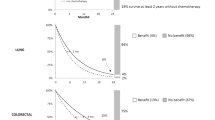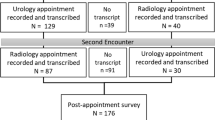Abstract
Goals of work
Although there are guidelines regarding how conversations with patients about prognosis in life-limiting illness should occur, there are little data about what doctors actually say. This study was designed to qualitatively analyze the language that oncologists and cancer patients use when talking about death.
Subjects and methods
We recruited 29 adults who had incurable forms of cancer, were scheduled for a first-time visit with one of six oncologists affiliated with a teaching hospital in Australia, and consented to having their visit audiotaped and transcribed. Using content analytic techniques, we coded various features of language usage.
Main results
Of the 29 visits, 23 (79.3%) included prognostic utterances about treatment-related and disease-related outcomes. In 12 (52.2%) of these 23 visits, explicit language about death (“terminal,” variations of “death”) was used. It was most commonly used by the oncologist after the physical examination, but it was sometimes used by patients or their kin, usually before the examination and involving emotional questioning about the patient’s future. In all 23 (100%) visits, implicit language (euphemistic or indirect talk) was used in discussing death and focused on an anticipated life span (mentioned in 87.0% of visits), estimated time frame (69.6%), or projected survival (47.8%).
Conclusions
Instead of using the word “death,” most participants used some alternative phrase, including implicit language. Although oncologists are more likely than patients and their kin to use explicit language in discussing death, the oncologists tend to couple it with implicit language, possibly to mitigate the message effects.
Similar content being viewed by others
References
Baile WF, Buckman R, Lenzi R, Glober G, Beale EA, Kudelka AP (2000) SPIKES—A six-step protocol for delivering bad news: application to the patient with cancer. Oncologist 5:302–311
Blanchard CG, Labreque BA, Ruckdeschel JC, Blanchard EB (1990) Physician behaviours, patient perceptions, and patient characteristics as predictors of satisfaction of hospitalized cancer patients. Cancer 65:186–192
Brown R, Butow PN, Dunn SM, Tattersall MH (2001) Promoting patient participation and shortening cancer consultations: a randomised trial. Br J Cancer 85:1273–1279
Buckman R (1984) Breaking bad news: why is it so difficult? BMJ 288:1597–1599
Buckman R (1992) How to break bad news: a guide for health care professionals. Johns Hopkins University Press, Baltimore
Burack JH (2000) Truth telling. In: Sugarman J (ed) Twenty common problems: ethics in primary care. McGraw-Hill, New York, pp 131–148
Campbell EM, Sanson-Fisher RW (1998) Breaking bad news. 3: Encouraging the adoption of best practices. Behav Med 24:73–80
Cassileth BR, Zupkis RV, Sutton-Smith K, March V (1980) Information and participation preferences among cancer patients. Ann Intern Med 92:832–836
Christakis N (2001) Death foretold: prophecy and prognosis in medical care. University of Chicago Press, Chicago
Cushing AM, Jones A (1995) Evaluation of a breaking bad news course for medical students. Med Educ 29:430–435
Ellis PM, Tattersall MH (1999) How should doctors communicate the diagnosis of cancer to patients? Ann Med 1:336–341
Fallowfield LJ, Hall A, Maguire GP, Baum M (1990) Psychological outcomes of different treatment policies in women with early breast cancer outside a clinical trial. BMJ 301:575–580
Fogarty LA, Curbow BA, Wingard JR, McDonnell K, Somerfield MR (1999) Can 40 seconds of compassion reduce patient anxiety? J Clin Oncol 17:371–379
Franks A (1997) Breaking bad news and the challenge of communication. Eur J Palliat Care 4:61–65
Garg A, Buckman R, Kason Y (1997) Teaching medical students how to break bad news. CMAJ 156:1159–1164
Hagerty RG, Butow PN, Ellis PM, Dimitry S, Tattersall MH (2005) Communicating prognosis in cancer care: a systematic review of the literature. Ann Oncol 16:1005–1053
Hagerty RG, Butow PN, Ellis PM et al (2005) Communicating with realism and hope: incurable cancer patients’ views on the disclosure of prognosis. J Clin Oncol 23:1278–1288
Hippocrates (1923) Decorum, XVI. In: Jones WH (ed) Hippocrates with an English translation, vol II. Heinemann, London
Krumholz HM, Phillips RS, Hamel MB et al (1998) Resuscitation preferences among patients with severe congestive heart failure: results from the SUPPORT project. Study to understand prognoses and preferences for outcomes and risks of treatments. Circulation 98:648–655
Kutner JS, Steiner JF, Corbett KK, Jahnigen DW, Barton PL (1999) Information needs in terminal illness. Soc Sci Med 48:1341–1352
Levinson W, Stiles WB, Inui TS, Engle R (1993) Physician frustration in communicating with patients. Med Care 31:285–295
Ley P (1982) Giving information to patients. In: Eiser JR (ed) Social psychology and behavioral medicine. Wiley, New York, p 353
Lobb EA, Butow PN, Kenny DT, Tattersall MH (1999) Communicating prognosis in early breast cancer: do women understand the language used? Med J Aust 171:290–294
Maguire P, Booth K, Elliott C, Jones B (1996) Helping health professionals involved in cancer care acquire key skills: the impact of workshops. Eur J Cancer 32A:1486–1489
Maguire P, Faulkner A (1988) How to improve the counselling skills of doctors and nurses in cancer care. BMJ 297:847–849
Markel H (1991) Cleopatra’s syndrome. Blaming the bearer of bad news. J Am Acad Physician Assist 4:669–670
McLauchlan CA (1990) Handling distressed relatives and breaking bad news. BMJ 301:1145–1149
Mitchell JL (1998) Cross-cultural issues in the disclosure of cancer. Cancer Pract 6:153–160
Miyaji NT (1993) The power of compassion: truth-telling among American doctors in the care of dying patients. Soc Sci Med 36:249–264
Oken D (1961) What to tell cancer patients: a study of medical attitudes. JAMA 175:1120–1128
Parker PA, Baile WF, de Moor C, Lenzi R, Kudelka AP, Cohen L (2001) Breaking bad news about cancer: patients’ preferences for communication. J Clin Oncol 9:2049–2056
Parle M, Jones B, Maguire P (1996) Maladaptive coping and affective disorders in cancer patients. Psychol Med 26:735–744
Percival T (1803) Medical ethics; or, code of institutes and precepts, adapted to the professional conduct of physicians and surgeons. Russell, Manchester, p 166
Ptacek JT, Eberhardt TL (1996) Breaking bad news. A review of the literature. JAMA 276:496–502
Quill TE, Townsend P (1991) Bad news: delivery, dialogue, and dilemmas. Arch Intern Med 151:463–468
Rabow MW, McPhee SJ (1999) Beyond breaking bad news: how to help patients who suffer. West J Med 171:260–263
Radovsky SS (1985) Bearing the news. N Engl J Med 313:586–588
Smith CK, Polis E, Hadac RR (1981) Characteristics of the initial medical interview associated with patient satisfaction and understanding. J Fam Pract 12:283–288
Stewart M, Brown JB, Boon H, Galajda J, Meredith L, Sangster M (1999) Evidence on patient–doctor communication. Cancer Prev Control 3:25–30
Sutherland HJ, Llewellyn-Thomas HA, Lockwood GA, Trichler DL (1989) Cancer patients: their desire for information and participation in treatment decisions. J R Soc Med 82:260–263
VandeKieft GK (2001) Breaking bad news. Am Fam Physician 64:1975–1978
Walsh RA, Girgis A, Sanson-Fisher RW (1998) Breaking bad news. 2: What evidence is available to guide clinicians? Behav Med 24:61–72
Weeks JC, Cook EF, O’Day SJ et al (1998) Relationship between cancer patients’ predictions of prognosis and their treatment preferences. JAMA 279:1709–1714
Acknowledgements
This research was supported in part by a grant awarded to Phyllis Butow, Ph.D., from the National Health and Medical Research Council of Australia (NH&MRC grant no. 950461).
Author information
Authors and Affiliations
Corresponding author
Rights and permissions
About this article
Cite this article
Rodriguez, K.L., Gambino, F.J., Butow, P. et al. Pushing up daisies: implicit and explicit language in oncologist–patient communication about death. Support Care Cancer 15, 153–161 (2007). https://doi.org/10.1007/s00520-006-0108-8
Received:
Accepted:
Published:
Issue Date:
DOI: https://doi.org/10.1007/s00520-006-0108-8




